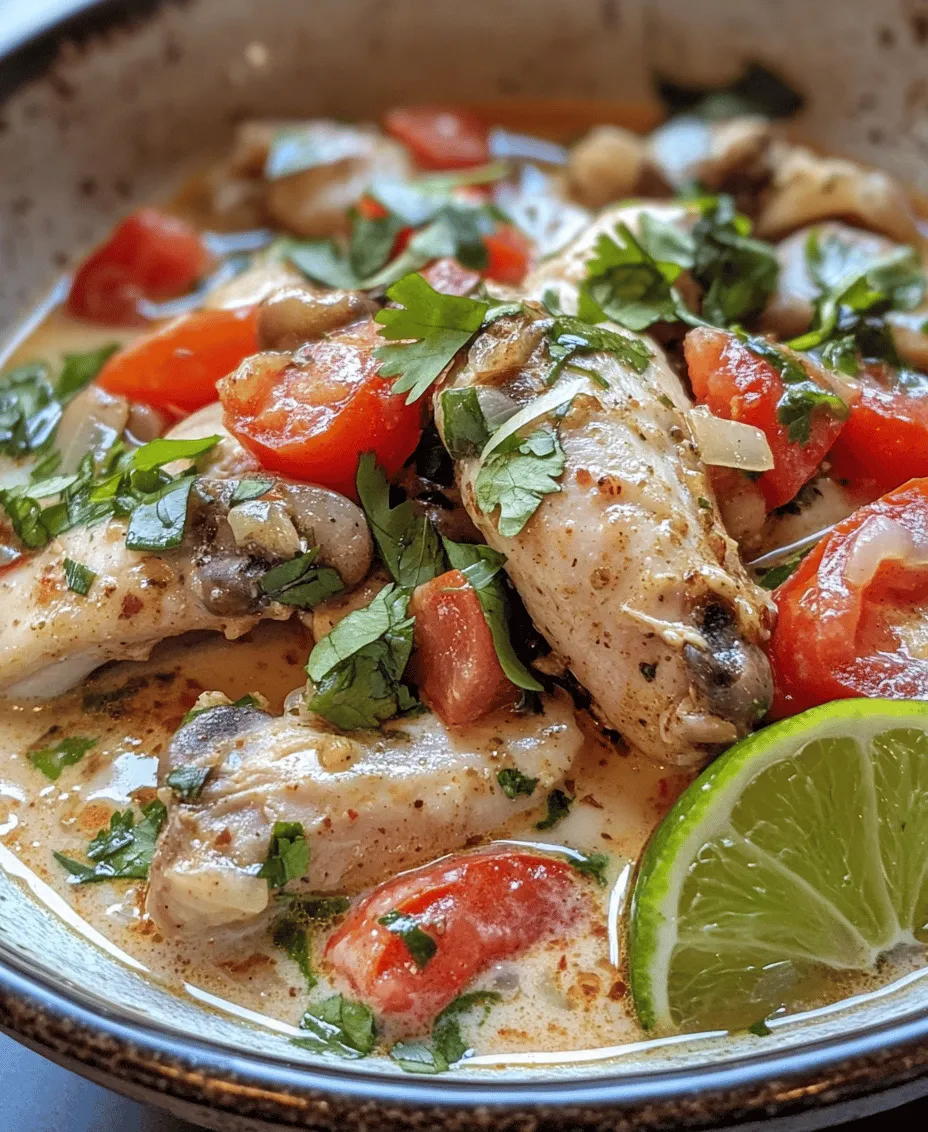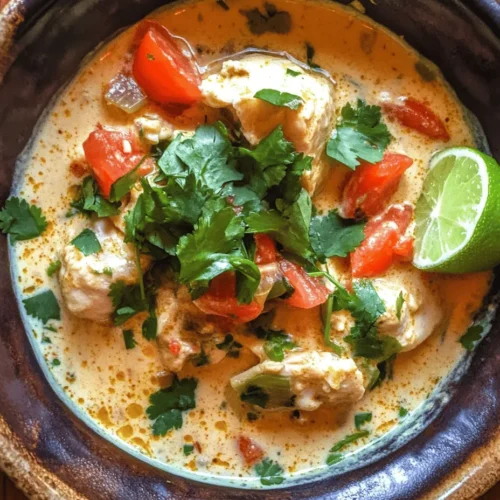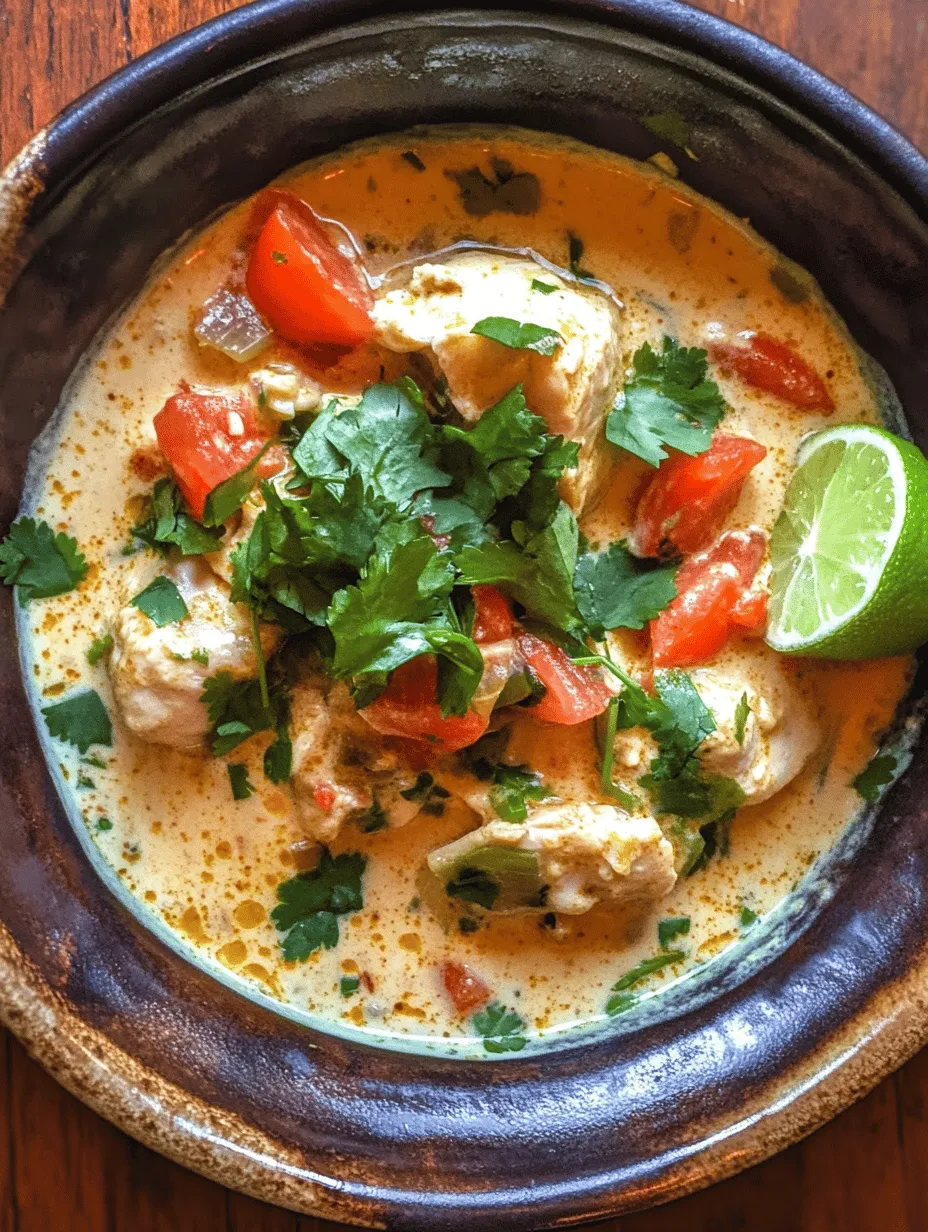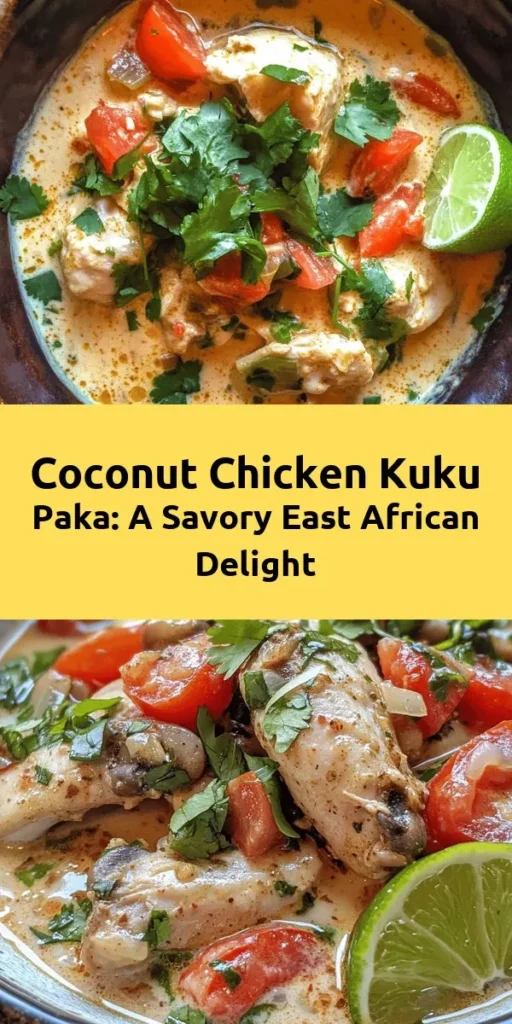Introduction
Kuku Paka is a beloved traditional dish that hails from East Africa, offering a delicious fusion of flavors that highlights the region’s rich culinary heritage. This aromatic chicken curry, which is generously infused with coconut milk, showcases a delightful blend of spices that reflects the diverse influences on East African cuisine, including Arab, Indian, and local African traditions. Kuku Paka not only tantalizes the taste buds but also embodies the communal spirit of East African dining, often served during special occasions and family gatherings.
The name “Kuku Paka” is derived from the Swahili words for “chicken” (kuku) and “coconut” (paka), aptly describing the dish’s key components. The creamy coconut sauce envelops tender chicken pieces, making it a comforting and satisfying meal. As we dive into the recipe, we will explore the essential ingredients that contribute to the dish’s distinctive flavor and texture, setting the stage for a culinary adventure that is sure to impress.
Understanding the Ingredients
Chicken
As the primary protein source in Kuku Paka, chicken plays a pivotal role in this dish. The choice of chicken, whether bone-in pieces or boneless cuts, influences the overall flavor. Bone-in chicken tends to yield a richer taste and more succulent texture due to the marrow and connective tissues that infuse the sauce during cooking. Alternatively, boneless chicken is favored for quicker preparation and easier serving. Regardless of the choice, ensuring the chicken is fresh and of high quality is essential for achieving the best results.
Coconut Milk
Coconut milk is the star ingredient that transforms Kuku Paka into a creamy, indulgent dish. Known for its rich and slightly sweet flavor, coconut milk not only enhances the sauce’s creaminess but also balances the spices’ heat, creating a harmonious blend. It is important to select high-quality coconut milk, preferably canned, as it offers a thicker consistency and a more robust coconut flavor compared to the powdered varieties. The creamy texture of coconut milk allows it to absorb the spices and aromatics, resulting in a luscious sauce that clings beautifully to the chicken.
Aromatics: Onions, Garlic, and Ginger
The trio of aromatics—onions, garlic, and ginger—forms the flavor foundation of Kuku Paka. Onions provide a sweet and savory base, while garlic and ginger add depth and complexity. When sautéed together, these ingredients release their natural oils and flavors, creating an aromatic base that elevates the dish. The timing of adding each aromatic is crucial; onions are typically cooked until translucent, followed by garlic and ginger, which should be added just before the spices to prevent burning and ensure their flavors are released optimally.
Spices: Coriander, Cumin, Turmeric, and Chili Powder
Spices are the heart and soul of Kuku Paka, infusing the dish with warmth and character. Coriander and cumin are often used together in many East African dishes, providing nutty and earthy notes. Turmeric adds a beautiful golden hue and a subtle bitterness, while chili powder introduces a kick of heat. The combination of these spices creates a well-rounded flavor profile that is both aromatic and comforting. It’s essential to toast the spices briefly before adding them to the sauce; this technique enhances their flavors and ensures they are fully activated, making the dish even more aromatic.
Fresh Cilantro and Lime Juice
To finish off Kuku Paka and enhance its overall flavor, fresh cilantro and lime juice are used as garnishes. Cilantro adds a burst of freshness and color, while lime juice introduces a tangy brightness that balances the richness of the coconut milk. A sprinkle of cilantro just before serving not only makes the dish visually appealing but also adds an extra layer of flavor that complements the creamy sauce and tender chicken.
Step-by-Step Guide to Making Kuku Paka
Marinating the Chicken
The first step in preparing Kuku Paka is marinating the chicken. This crucial process allows the chicken to absorb the flavors of the spices and aromatics, resulting in a more flavorful final dish. To marinate, combine yogurt or lemon juice with spices such as turmeric, coriander, and chili powder, and coat the chicken pieces thoroughly. Allow the marinated chicken to sit for at least 30 minutes, or ideally, refrigerate it for several hours or overnight. This extra time not only enhances the flavor but also tenderizes the meat, making it juicier when cooked.
Preparing the Sauce
Once the chicken is marinated, it’s time to prepare the sauce. Start by heating oil or ghee in a large skillet or pot over medium heat. Add finely chopped onions and sauté them until they become translucent and golden brown. This caramelization process is vital, as it develops the foundational sweetness and depth of flavor necessary for a rich sauce. Stir occasionally to prevent the onions from burning, which can impart a bitter taste to the dish.
Adding Aromatics
After the onions are perfectly sautéed, add minced garlic and grated ginger to the pan. Sauté them for just a minute or two until fragrant; be cautious not to overcook them, as burnt garlic can give the sauce an unpleasant flavor. Stirring continuously will help release the essential oils and flavors of the garlic and ginger, ensuring they meld beautifully with the onions.
Cooking the Tomatoes
Next, it’s time to incorporate fresh or canned tomatoes into the mixture. If using fresh tomatoes, chop them into small pieces; if using canned, simply pour them into the pan. The tomatoes are essential for adding acidity and balance to the dish. Allow the mixture to cook for approximately 5-7 minutes, or until the tomatoes break down and integrate into the sauce. This step is crucial, as it helps achieve the desired consistency of the sauce while also intensifying the flavors.
Incorporating Spices
With the tomatoes cooked down, it’s time to add the spices—coriander, cumin, turmeric, and chili powder. Sprinkle them over the tomato mixture and stir well to coat everything evenly. Toasting the spices in the oil allows their flavors to bloom, resulting in a more aromatic and flavorful sauce. Allow the spices to cook for about 1-2 minutes, stirring frequently to prevent burning. This step will not only enhance the flavor of the sauce but will also fill your kitchen with a tantalizing aroma that hints at the delicious meal to come.
—
This introduction and initial steps of the Kuku Paka recipe set the stage for a flavorful journey through East African cuisine. With its rich history, vibrant ingredients, and step-by-step guidance, this dish is sure to delight your taste buds and impress your family and friends. Stay tuned for the remaining steps that will help you perfect this delightful coconut chicken dish!

Simmering the Chicken: Tips for Achieving Tender, Flavorful Chicken
Once your chicken is marinated to perfection, it’s time to bring it to life in the pot. Simmering is a crucial step in the Kuku Paka recipe that ensures the chicken remains tender and flavorful. Here are key tips to master this process:
1. Choose the Right Cooking Vessel: A heavy-bottomed pot or Dutch oven is ideal for simmering. These types of cookware distribute heat evenly and help avoid hot spots that could lead to uneven cooking.
2. Use a Lid: Covering the pot while simmering helps to retain moisture and heat, making sure the chicken cooks evenly without drying out.
3. Control the Temperature: After bringing your coconut sauce to a gentle boil, reduce the heat to low to maintain a steady simmer. Too high of a temperature can toughen the chicken and cause the coconut milk to separate.
4. Simmer Time: Allow the chicken to simmer gently for about 30-40 minutes. This will ensure that the chicken absorbs the flavors of the coconut milk and spices. If using bone-in pieces, you might need to extend the cooking time slightly.
5. Check for Doneness: The chicken is done when it reaches an internal temperature of 165°F (75°C) or when the juices run clear when pierced. If you’re using boneless, skinless chicken thighs or breasts, they may cook faster, so keep a close eye on them.
Final Touches: Adjusting Seasoning and Sauce Consistency for the Perfect Finish
Once your chicken is tender and infused with flavor, you’ll want to ensure that the sauce is just right:
1. Taste and Adjust: Before serving, taste your sauce. You may find it needs a touch more salt or a hint of acidity. A squeeze of fresh lime juice can brighten the flavors without overpowering the dish.
2. Thickening the Sauce: If you prefer a thicker sauce, remove the lid and let it simmer uncovered for an additional 5-10 minutes. This will allow excess liquid to evaporate and concentrate the flavors. Conversely, if the sauce is too thick, you can stir in a bit of water or additional coconut milk to reach your desired consistency.
3. Finishing Touches: Consider adding a handful of fresh cilantro or parsley just before serving for a fresh, herbal note that complements the rich coconut flavor.
Serving Suggestions
Kuku Paka is best enjoyed with a variety of sides that enhance its delightful flavors. Here are some traditional accompaniments and presentation tips:
Best Accompaniments for Kuku Paka
– Rice: Steamed basmati or jasmine rice is a classic pairing that absorbs the rich coconut sauce beautifully.
– Chapati: This unleavened flatbread is perfect for scooping up the chicken and sauce, making each bite a textural delight.
– Ugali: A staple in East African cuisine, this maize porridge is hearty and complements the dish’s flavors well.
Creative Serving Ideas
To elevate your dining experience, consider the following presentation tips:
– Serve in a Casserole Dish: Presenting Kuku Paka in a colorful casserole dish can enhance the visual appeal of your meal.
– Garnish: Sprinkle chopped cilantro or toasted coconut on top for added flavor and texture. A few lime wedges on the side can also invite guests to customize their dish.
– Plate with Style: For a more upscale experience, plate the chicken over a mound of rice, drizzle with sauce, and add a decorative sprig of herbs.
Pairing Beverages
To complement the rich flavors of Kuku Paka, consider these beverage pairings:
– Chilled White Wine: A crisp Sauvignon Blanc or a light Pinot Grigio can balance the richness of the dish.
– Tropical Juices: Freshly squeezed juices like mango or pineapple add a refreshing contrast.
– Herbal Teas: A calming peppermint or chamomile tea can serve as a soothing end to the meal.
Nutritional Information
Kuku Paka is not just a comforting dish; it also offers a variety of nutritional benefits:
Overview of Nutritional Value
A standard serving of Kuku Paka (approximately one cup) can contain:
– Calories: Around 350-400 calories depending on the portion size and specific ingredients used.
– Protein: Approximately 25-30 grams from the chicken.
– Fats: Rich in healthy fats from coconut milk, providing 20-25 grams, primarily saturated fat.
– Carbohydrates: If served with rice or chapati, expect around 40-50 grams of carbs.
Health Benefits of Coconut Milk and Spices Used in the Recipe
Coconut milk is a star ingredient in Kuku Paka, offering several health benefits:
– Heart Health: The medium-chain triglycerides (MCTs) in coconut milk can support heart health and promote weight loss.
– Antioxidants: Spices like turmeric and ginger not only add flavor but also have anti-inflammatory properties and can aid digestion.
Discussion on Portion Sizes and Serving Recommendations
For a well-balanced meal, consider serving Kuku Paka with a side of vegetables or a salad. Adjust portion sizes based on individual dietary needs, but aim for a protein-rich serving alongside carbohydrates and healthy fats.
Variations and Customizations
Kuku Paka is a versatile dish that can be customized to suit various dietary preferences and tastes. Here are some ideas:
Overview of Possible Variations
– Vegetarian Options: Substitute chicken with tofu or chickpeas. The marinating process can still apply, giving these alternatives a robust flavor profile.
– Alternative Proteins: Consider using fish or shrimp for a seafood variation. Adjust cooking times accordingly, as these proteins cook faster than chicken.
– Spice Levels: Adjust the heat by adding more or less chili pepper or incorporating spices like cayenne for a spicier kick.
Suggestions for Additional Ingredients
To enhance the nutritional value and flavor profile of Kuku Paka, consider adding:
– Vegetables: Bell peppers, zucchini, or spinach can be added during the simmering process for added color and nutrients.
– Legumes: Adding lentils or peas can increase the protein and fiber content of the dish, making it even more hearty.
Cultural Variations of Kuku Paka Across East Africa
Kuku Paka has regional variations across East Africa, reflecting local ingredients and culinary traditions. For instance:
– Tanzanian Kuku Paka: Often includes a spicier coconut sauce with an added layer of flavor from local spices.
– Kenyan Variants: May incorporate different vegetables or herbs, such as fresh basil or even peanut sauce for a nutty twist.
Conclusion
Kuku Paka is more than just a dish; it is a celebration of East African flavors and culinary traditions. Its comforting blend of spices, tender chicken, and rich coconut sauce creates a delightful experience that can be enjoyed by family and friends alike.
As you embark on making Kuku Paka, embrace the cooking process and the cultural roots behind this traditional dish. Share it with loved ones, and relish the joy of gathering around the table to enjoy a meal that speaks to the heart of East African cuisine. By exploring and sharing such recipes, we keep our culinary heritage alive and introduce new flavors to our lives. Enjoy the journey of cooking, and don’t hesitate to make this dish your own!



